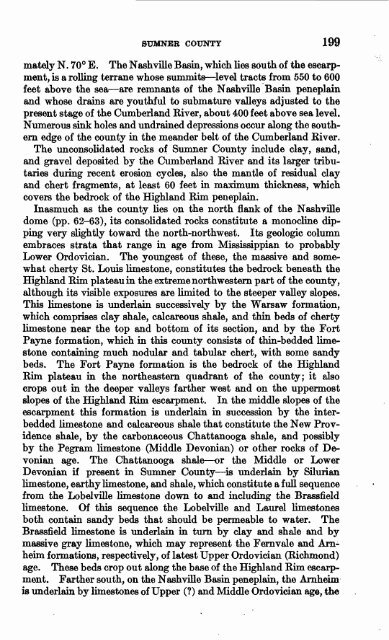GROUND WATER IN NORTH-CENTRAL TENNESSEE
GROUND WATER IN NORTH-CENTRAL TENNESSEE
GROUND WATER IN NORTH-CENTRAL TENNESSEE
You also want an ePaper? Increase the reach of your titles
YUMPU automatically turns print PDFs into web optimized ePapers that Google loves.
StJMNEB COUNTY 199<br />
mately N. 70° E. The Nashville Basin, which lies south of the escarp<br />
ment, is a rolling terrane whose summits level tracts from 550 to 600<br />
feet above the sea are remnants of the Nashville Basin peneplain<br />
and whose drains are youthful to submature valleys adjusted to the<br />
present stage of the Cumberland River, about 400 feet above sea level.<br />
Numerous sink holes and undrained depressions occur along the south<br />
ern edge of the county in the meander belt of the Cumberland River.<br />
The unconsolidated rocks of Sumner County include clay, sand,<br />
and gravel deposited by the Cumberland River and its larger tribu<br />
taries during recent erosion cycles, also the mantle of residual clay<br />
and chert fragments, at least 60 feet in maximum thickness, which<br />
covers the bedrock of the Highland Rim peneplain.<br />
Inasmuch as the county lies on the north flank of the Nashville<br />
dome (pp. 62-63), its consolidated rocks constitute a monocline dip<br />
ping very slightly toward the north-northwest. Its geologic column<br />
embraces strata that range in age from Mississippian to probably<br />
Lower Ordovician. The youngest of these, the massive and some<br />
what cherty St. Louis limestone, constitutes the bedrock beneath the<br />
Highland Rim plateau in the extreme northwestern part of the county,<br />
although its visible exposures are limited to the steeper valley slopes.<br />
This limestone is underlain successively by the Warsaw formation,<br />
which comprises clay shale, calcareous shale, and thin beds of cherty<br />
limestone near the top and bottom of its section, and by the Fort<br />
Payne formation, which in this county consists of thin-bedded lime<br />
stone containing much nodular and tabular chert, with some sandy<br />
beds. The Fort Payne formation is the bedrock of the Highland<br />
Rim plateau in the northeastern quadrant of the county; it also<br />
crops out in the deeper valleys farther west and on the uppermost<br />
slopes of the Highland Rim escarpment. In the middle slopes of the<br />
escarpment this formation is underlain in succession by the inter-<br />
bedded limestone and calcareous shale that constitute the New Prov<br />
idence shale, by the carbonaceous Chattanooga shale, and possibly<br />
by the Pegram limestone (Middle Devonian) or other rocks of De<br />
vonian age. The Chattanooga shale or the Middle or Lower<br />
Devonian if present in Sumner County is underlain by Silurian<br />
limestone, earthy limestone, and shale, which constitute a full sequence<br />
from the Lobelville limestone down to and including the Brassfield<br />
limestone. Of this sequence the Lobelville and Laurel limestones<br />
both contain sandy beds that should be permeable to water. The<br />
Brassfield limestone is underlain in turn by clay and shale and by<br />
massive gray limestone, which may represent the Fernvale and Ara-<br />
heim formations, respectively, of latest Upper Ordovician (Richmond)<br />
age. These beds crop out along the base of the Highland Rim escarp<br />
ment. Farther south, on the Nashville Basin peneplain, the Arnheim<br />
is underlain by limestones of Upper (?) and Middle Ordovician age, the

















